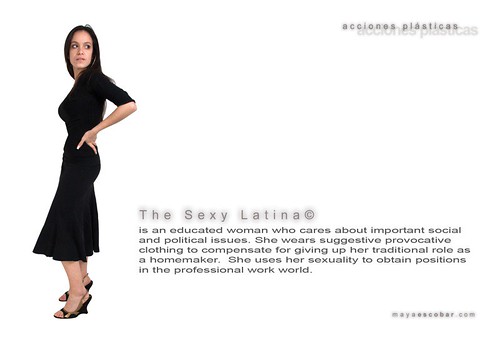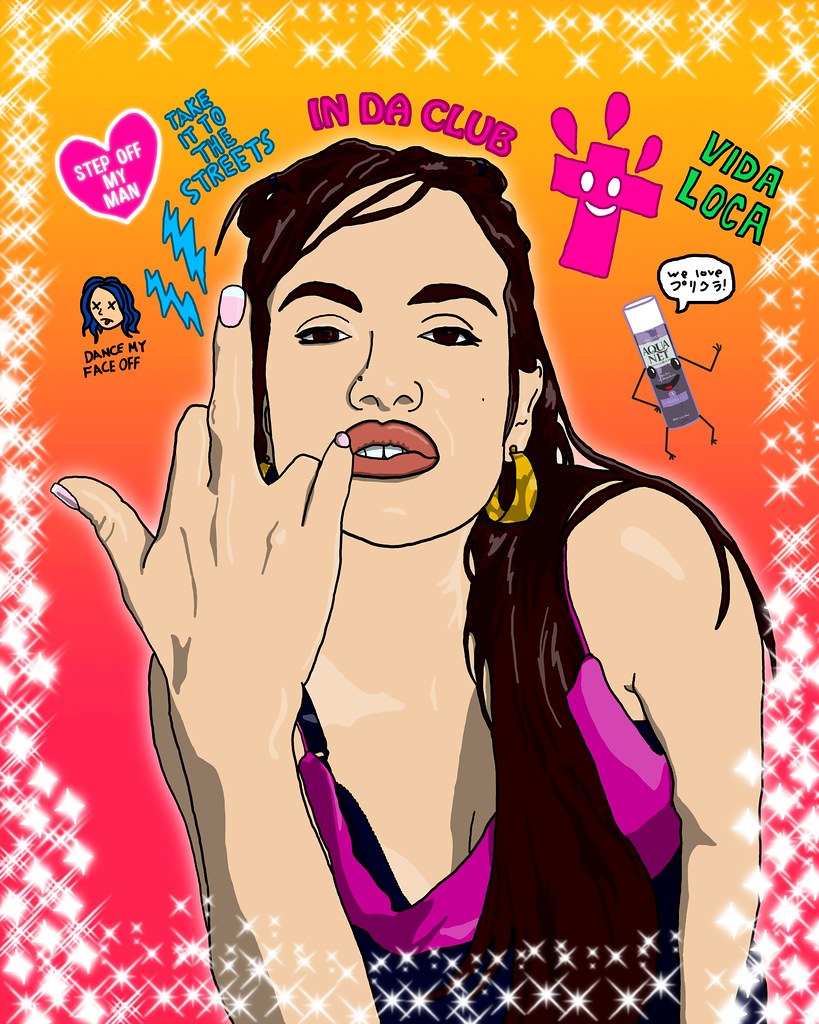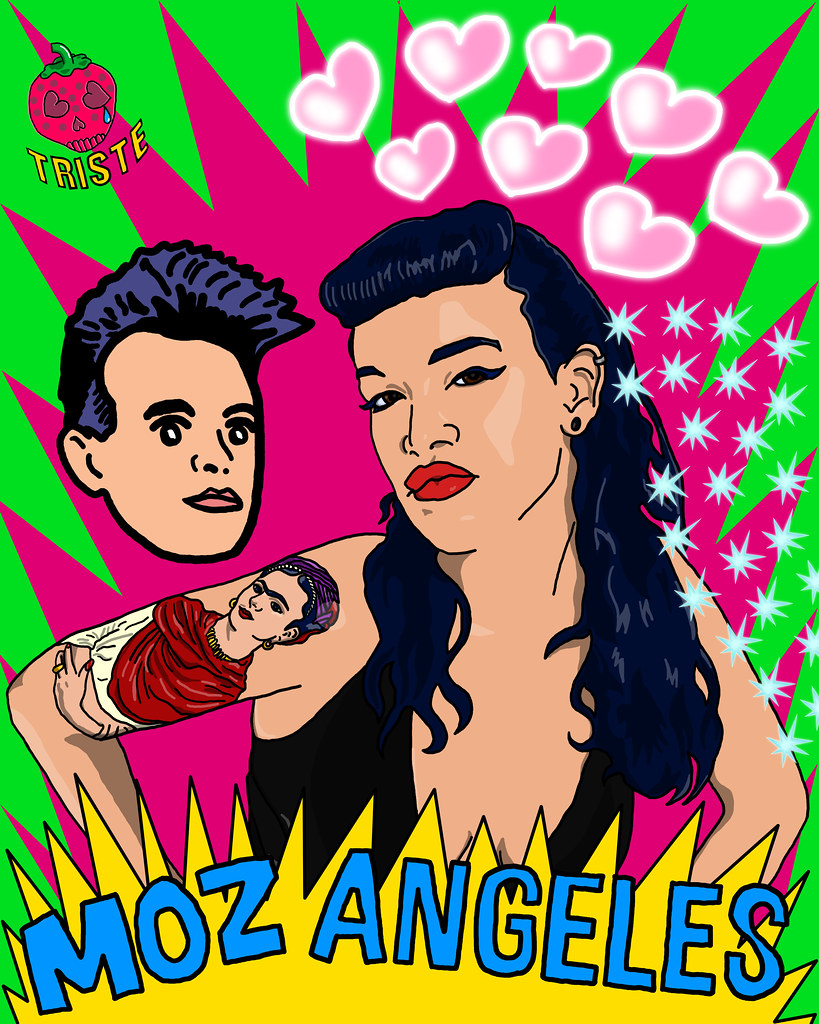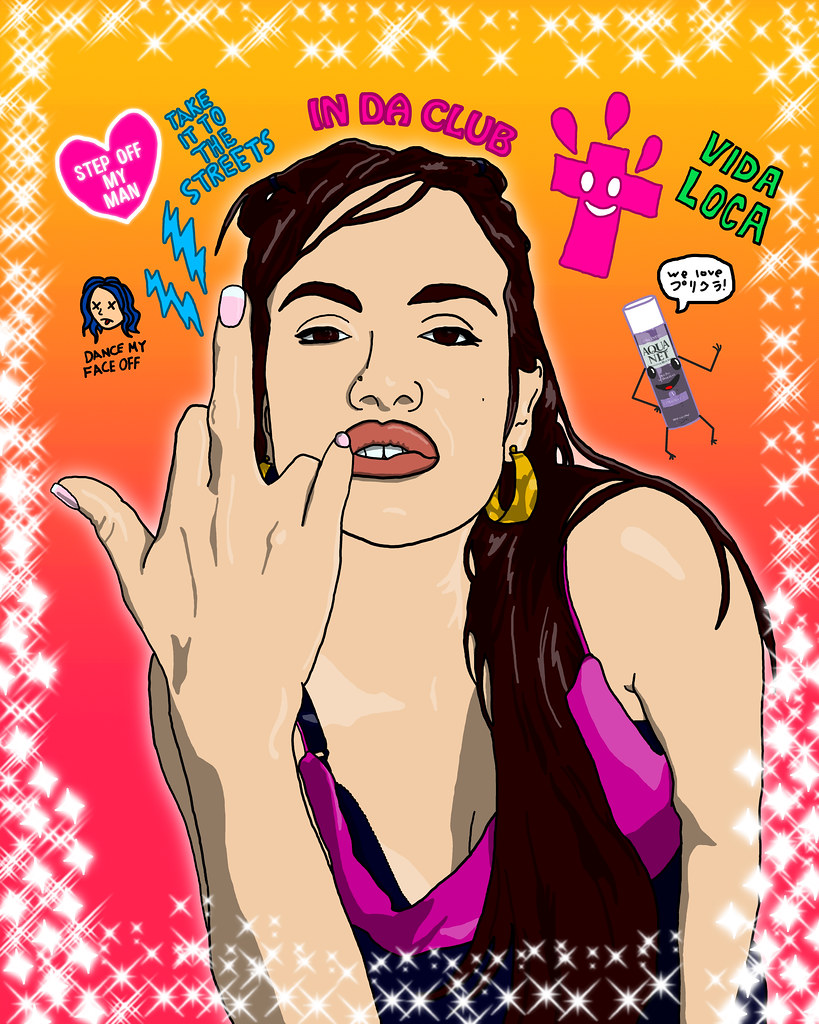In her essay The Myth of the Latina Woman/ Just Met a Girl Named Maria, Judith Ortiz Cofer describes her Puerto Rican upbringing in a strict Catholic home in New Jersey, where she was taught to behave like a proper señorita. Cofer explains that the conflicting messages she received as a child, were those commonly propagated by Puerto Rican mothers. “They encourage their daughters to look and act like women and to dress in clothes that our Anglo friends and their mothers found to mature for our age.”When the mere notion of latinidad equates passion and sexuality to gringos, why is it that Latino men are the first ones to point finger and to call these same women suelta (loose) or facil (easy)? Wouldn’t they understand? Have they not been subjected to the same treatment? Perhaps it is comes down to the way they were raised.In the Latino culture ideas of masculinity and femininity are delineated very early on. Author Evelyn P. Stevens, first introduced this concept know as machismo and marianismo in 1973. Machismo grants supreme authority of the man over the woman. Under this doctrine women, who are considered to be morally and spiritually superior to men are able to endure abuse. They grow up expected to follow the sexual code of marianismo, and are submissive to the man’s authority.Puerto Rican culture places women into one of two categories the virgin or the whore; mujeres de la casa (women of the home) or mujeres de la calle (women of the street). Una mujer de la casa, is expected to be pure, giving and compassionate. While, una mujer de la calle is considered to be sluty, wild, and dangerous.In Honor and the American Dream: Culture and Identity in a Chicano Community, author Ruth Horowitz says the following:The very presence of a woman outside the household implicates them in promiscuity and/or sexual misconduct. Puerto Rican girls learn this good girl/bad girl dichotomy most clearly in the recruitment into reproductive labor… A good girl cooks, cleans, takes care of younger siblings, and helps her parents. In contrast una muchacha de la calle is a transgressive women who has gone beyond patriarchal control whose sexuality is unbounded and therefore dangerous.While in Puerto Rico this January, I had the privilege of meeting the incredibly talented video artist, Tamara Liz Rivera Boria. Tamara and I instantly bonded, finding similarity in the content of our work, and decided that we needed to collaborate.I conducted a short series of interviews with her (documented with the camera from my laptop), where she describes her work as it plays on the screen behind her…[youtube=http://www.youtube.com/watch?v=I2SdDl2zaus] click on above image to view videoInterview with Puerto Rican Artist Tamara Liz Rivera BoriaMaya: Tamara, what can you tell me about muchachas de la calle and muchachas de las casa?Tamara: De la casa and de la calle girls might as well be related. They exchange roles sometimes, de la casa girl wanting to be de la calle, and vice versa.Maya: How has this affected you?Tamara: I was raised in a catholic home, in a catholic school. I can tell you, I have been fucked up. I didn’t want to be told what to do, or what to believe in.How can you tell someone that using a condom is a sin? I had many issues over the years being raised like that. Even though my parents are not Catholic extremists. They were pretty easy going that’s how they could understand me or deal with me. Deep inside it made a mark, no matter how much I tried to live and understand the world. I became insane trying to understand other people lifestyle because indeed I might have been raised inside a bubble. I still am kind of in there, don’t wanting to look at how things really are.Maya: What role does your cultural upbringing play in your work?Tamara: Recently I made a video called él, baño de marîa. In this video I present various symbolism about religion, pecados (sins), sexuality, purity, faith among other things. Mainly because our culture has raised us thinking inside the box, controlling us with Christianity, especially Catholicism. Being pure, waiting till marriage although most don’t do it, is deep inside the mind. Like it is wrong to embrace sexuality.Aglubium, is another video I made in collaboration with Ralph Vazquez and Rebecca Adorno. In this video I am drowning, or trying to kill myself by submerging my head in the water. It’s aggressive, and it’s beautiful. We just want to end, we don’t want to think. We don’t want to face fears. We don’t want to wait, we want to get it over. We want to drown our fears. We don’t want to face reality. Escape its what we do.Maya: How do you escape?Tamara: Most people (Puerto Ricans) use drugs. Puerto Ricans that do not use illegal drugs, use legal pills, alcohol or even coffee. Everyone has an addiction. It’s a shame but I have seen most of my friends doing drugs. I been there, I done that but I never had an addiction. My new boyfriend said I was an alcoholic, he didn’t believe me when I said I wasn’t. It wasn’t till he lived with me for over a moth when he saw that I didn’t drink for so long that he believed me, and with the cigarettes the same.For some weird reason I can try things for as long as I want and not create any addiction. I wish it were the same with those that surround me. But in the arts almost all the people I know use some kind of drugs, are the ones that worry me the most are the most intelligent that keep using. I guess they are not that smart…Maya: Is there an alternative to escape?Tamara: I can see clearly that with true art I can make a difference, I can say what I understand to be real and important. I might help somebody. Other people just ignore what is going on (Puerto Rico). So many things had happen here, that demanded the people marching up the streets in protest, because our government is insane. But people don’t, they just “sit quietly”. They don’t want to get involved, they think they cannot change anything. They believe they have no power, when indeed I say, with all your power, what would you do? – I love that flaming lips song-Maya: How does this affect Puerto Rican girls?Tamara: Puerto Rican girls have many issues. Not only because of gringos (Americans) our identity issues extend into religion and the ways women are portrayed in the reggaeton culture. Girls want to be thin like gringas (American girls), they don’t like they’re beautiful curves, ass and tits. They always feel fat no matter how thin they are. I bet this happen everywhere, but these are issues we shouldn’t have.Accepting ourselves, as we are its what we should do. Because we are not gringas! We are not blonde and white! But boys see these girls in TV, and everywhere and they expect girls like that. It’s the gringo media. I’ve forgotten all about this, but I also had these issues. I think I kind of still do, I just ignore most of the time.Maya: You mentioned Reggaeton, what message do you think Reggaeton is sending to young women?Tamara: Reggaeton is a part of that movement leads ladies to feeling less than the man, like he has to buy her. Girls learn to use their sexual power way to early with reggaeton. It is a confrontation for some, between what they like (reggaeton movement, lifestyle) and the religious foundation they might have. But since it probably was forced (religion) they escaped thru reggaeton. Ultimately ending in ugly situations.Maya: Okay , I agree with you. But I am not going to lie, I love reggaeton… are you sure you don’t secretly like it?Tamara: I don’t dig reggaeton; I see how girls embrace being just a piece of meat, especially high schools girls. How much is this necklace, like a million? Said a girl, the boy answered – no. The girl said - well then, work and buy me this necklace.Yesterday I heard a senior girl say that to her boyfriend at a hotel, it was their prom. Girls parade in lil’ dresses, easily they could have been mistaken for high-class whores. I won’t even comment on the dancing. It has gotten worse, every time. Since parents are so young they allow they’re children to behave like this. I mean, I see a problem with these situations. Boys catch another boy,looking at their girls, no matter if its sexual or if they just passed and look because its simply there, they get all worked up and want to fight. What is that dumbass looking at? So basically, what, people cant look at each other now? Girls can’t stand if you look at them either. Puerto Rico was not like that; you went to the mall, smiled and people smiled back at you.The reggaeton anger and sexual damage can be easily identified. Even kindergarten boys are sexually harassing little girls. My mom is a teacher and I have heard some stories. I haven’t analyzed reggaeton issues deeply; this is just for what I have seen.Maya: Thank you for your insight Tamara, I can’t wait to see what you produce next. I hope we can collaborate together in the future.Tamara: I know I could make more sense out of my ideas, since they’re not organized very well, but it doesn’t matter. This is just the beginning of many wonderful works to come, ideas to flow… I’m glad that I can collaborate with you.
click on above image to view videoInterview with Puerto Rican Artist Tamara Liz Rivera BoriaMaya: Tamara, what can you tell me about muchachas de la calle and muchachas de las casa?Tamara: De la casa and de la calle girls might as well be related. They exchange roles sometimes, de la casa girl wanting to be de la calle, and vice versa.Maya: How has this affected you?Tamara: I was raised in a catholic home, in a catholic school. I can tell you, I have been fucked up. I didn’t want to be told what to do, or what to believe in.How can you tell someone that using a condom is a sin? I had many issues over the years being raised like that. Even though my parents are not Catholic extremists. They were pretty easy going that’s how they could understand me or deal with me. Deep inside it made a mark, no matter how much I tried to live and understand the world. I became insane trying to understand other people lifestyle because indeed I might have been raised inside a bubble. I still am kind of in there, don’t wanting to look at how things really are.Maya: What role does your cultural upbringing play in your work?Tamara: Recently I made a video called él, baño de marîa. In this video I present various symbolism about religion, pecados (sins), sexuality, purity, faith among other things. Mainly because our culture has raised us thinking inside the box, controlling us with Christianity, especially Catholicism. Being pure, waiting till marriage although most don’t do it, is deep inside the mind. Like it is wrong to embrace sexuality.Aglubium, is another video I made in collaboration with Ralph Vazquez and Rebecca Adorno. In this video I am drowning, or trying to kill myself by submerging my head in the water. It’s aggressive, and it’s beautiful. We just want to end, we don’t want to think. We don’t want to face fears. We don’t want to wait, we want to get it over. We want to drown our fears. We don’t want to face reality. Escape its what we do.Maya: How do you escape?Tamara: Most people (Puerto Ricans) use drugs. Puerto Ricans that do not use illegal drugs, use legal pills, alcohol or even coffee. Everyone has an addiction. It’s a shame but I have seen most of my friends doing drugs. I been there, I done that but I never had an addiction. My new boyfriend said I was an alcoholic, he didn’t believe me when I said I wasn’t. It wasn’t till he lived with me for over a moth when he saw that I didn’t drink for so long that he believed me, and with the cigarettes the same.For some weird reason I can try things for as long as I want and not create any addiction. I wish it were the same with those that surround me. But in the arts almost all the people I know use some kind of drugs, are the ones that worry me the most are the most intelligent that keep using. I guess they are not that smart…Maya: Is there an alternative to escape?Tamara: I can see clearly that with true art I can make a difference, I can say what I understand to be real and important. I might help somebody. Other people just ignore what is going on (Puerto Rico). So many things had happen here, that demanded the people marching up the streets in protest, because our government is insane. But people don’t, they just “sit quietly”. They don’t want to get involved, they think they cannot change anything. They believe they have no power, when indeed I say, with all your power, what would you do? – I love that flaming lips song-Maya: How does this affect Puerto Rican girls?Tamara: Puerto Rican girls have many issues. Not only because of gringos (Americans) our identity issues extend into religion and the ways women are portrayed in the reggaeton culture. Girls want to be thin like gringas (American girls), they don’t like they’re beautiful curves, ass and tits. They always feel fat no matter how thin they are. I bet this happen everywhere, but these are issues we shouldn’t have.Accepting ourselves, as we are its what we should do. Because we are not gringas! We are not blonde and white! But boys see these girls in TV, and everywhere and they expect girls like that. It’s the gringo media. I’ve forgotten all about this, but I also had these issues. I think I kind of still do, I just ignore most of the time.Maya: You mentioned Reggaeton, what message do you think Reggaeton is sending to young women?Tamara: Reggaeton is a part of that movement leads ladies to feeling less than the man, like he has to buy her. Girls learn to use their sexual power way to early with reggaeton. It is a confrontation for some, between what they like (reggaeton movement, lifestyle) and the religious foundation they might have. But since it probably was forced (religion) they escaped thru reggaeton. Ultimately ending in ugly situations.Maya: Okay , I agree with you. But I am not going to lie, I love reggaeton… are you sure you don’t secretly like it?Tamara: I don’t dig reggaeton; I see how girls embrace being just a piece of meat, especially high schools girls. How much is this necklace, like a million? Said a girl, the boy answered – no. The girl said - well then, work and buy me this necklace.Yesterday I heard a senior girl say that to her boyfriend at a hotel, it was their prom. Girls parade in lil’ dresses, easily they could have been mistaken for high-class whores. I won’t even comment on the dancing. It has gotten worse, every time. Since parents are so young they allow they’re children to behave like this. I mean, I see a problem with these situations. Boys catch another boy,looking at their girls, no matter if its sexual or if they just passed and look because its simply there, they get all worked up and want to fight. What is that dumbass looking at? So basically, what, people cant look at each other now? Girls can’t stand if you look at them either. Puerto Rico was not like that; you went to the mall, smiled and people smiled back at you.The reggaeton anger and sexual damage can be easily identified. Even kindergarten boys are sexually harassing little girls. My mom is a teacher and I have heard some stories. I haven’t analyzed reggaeton issues deeply; this is just for what I have seen.Maya: Thank you for your insight Tamara, I can’t wait to see what you produce next. I hope we can collaborate together in the future.Tamara: I know I could make more sense out of my ideas, since they’re not organized very well, but it doesn’t matter. This is just the beginning of many wonderful works to come, ideas to flow… I’m glad that I can collaborate with you.
“Everything that surrounds me, mi entorno, makes a part of who I am and what I say in my videos. Little by little its somehow implicated.”
As I begrudgingly stated in my interview with Tamara, I am a fan of reggaeton. Like most, I don’t even acknowledge the lyrics or really think too much beyond the beat of the music. Yet now I find myself wondering, are most girls conscious of the message? I guess to some extent they must be, after all as Tamara shared many sing the lyrics as they grind (rub up) on men.In my research I found extensive commentary regarding the direction of Salsa and its implications on women in the Puerto Rican community. However, as it is relatively new form of music, the writing concerning Reggaeton seems to be incredibly limited.So I turned to a more contemporary source and found a blog entitled REGGAETONICA, written by Raquel Z. Rivera; author of New York Ricans from the Hip Hop Zone. In a recent post: From White to Mulata: The Darkening Powers of Reggaetón, she shares an email addressing this very issue:
I think reggaeton has been raunchy & explicitly all along, but I think the lyrics have reverted back to the "Reggeaton Sex" days of Underground. I think that "raunchiness" & degradation have become more mainstream & therefore are seen as less scandalous & more acceptable to society, so I think it has questioned our value as a community. The fact that Reggaeton outright refers to sexual references & acts & is accepted as mainstream Puerto Rican culture posing an interesting cultural issue for me. Now you can go to Puerto Rico and see young girls singing "dame con el palo, " & they're parents paying no mind to it, which I think is crazy. In the beginning of Reggaeton I found the lyrics to be much more raunchy, violent, & drug-related. Then mainstream Reggaeton came along, switched the "sexo" to "amor" & the "nenas" to "gatas." I think these subtle changes in language allowed Reggaeton to be more successful in the mainstream, but now a lot of artists are moving back to the original lyrics because they already have a stable fan base. I mean, look at someone like Tony Dize, if you translated some of his songs into English, they could put even 50 Cent to shame with the blatant sexual references & degradation of women.
Perhaps reggaeton is so widely accepted by mainstream and popular culture, because it provides a free ticket to promote these concepts in a non-threatening form. If Puerto Rican women and other Latinas are fine dancing to this music, then what harm is there in gringos doing the same.This then becomes representative of Puerto Rican culture. When a gringa dances to reggaeton she can purse her lips and grind on men, but without an attached stigma. She is just acting like a Latina girl. The Puerto Rican girls participating in this scene are aiding in the further perpetuation of the stereotype of Latina’s being easy.However, as Tamara explained a lot of this has to do with a search for independence. Wanting to rebel against the forced restrictions of being una mucha de la casa, girls go to the furthest extreme to break down those barriers. But to what cost?I myself am unable to provide a concrete solution. Yet I do think that one of the primary steps to forward progress is conversation. Tamara and myself have opted to publish the text on the web so that others may join in the dialog…[youtube=http://www.youtube.com/watch?v=rxiWzxItuzo]













